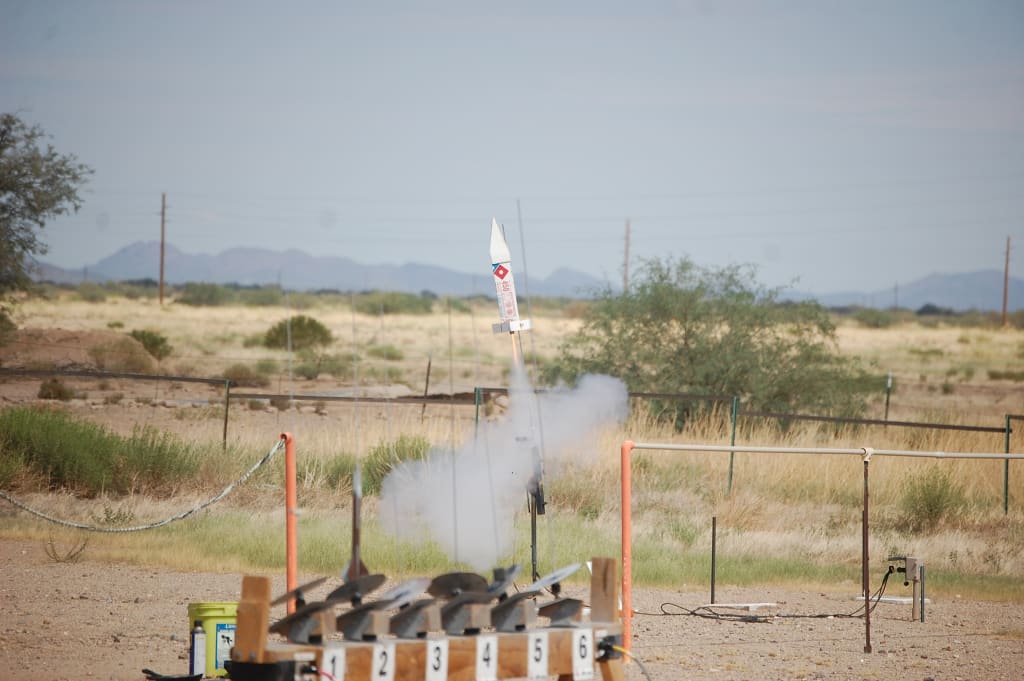A Trek to Inner Peace
Rockets Require lots of Zen

You must be a Zen master to do the hobby of rocketry, well. Every part of the hobby requires discipline. Let your concentration slip, and the rocket may not fly again at the least. Hopefully, it does not cause a problem. You can just put the kit together, or you can make a masterpiece. Something that other hobbyists will respect. Make it an expression of perfection.
Now you can make a rocket, but math controls its design. The ratio of width to length are well known. The size and shape of the fins are made to a formula. The nose cone is a smooth geometric curve. A tube with fins. Rockets tend to look the same, except for mine.
I like to make my rockets out of cereal boxes or pizza boxes. Mine are not round. My rockets have three sides. Moreover, the loop-type fins have a huge flat area to glue versus one thin edge to a tube of round rockets. The best part is that the graphics on the box is now on the rocket. You can have a rocket the features your favorite cereal box hero.
Making the rocket is only part of the battle. You must also launch the rocket. The engines can be a problem. First, they must be held secure. When the back charge fires, opening the rocket, the engine must not eject. Most engine mounts use a clip to hold the engine in place.
Next, you must ignite the engine. This requires that you connect the ignition clips to the ignitor you placed in the engine. The small wires of the ignitor are hard to clip, and the clips cannot touch each other or the blast shield.
The engine must not be dropped. Fuel grains such as black powder are solid. If cracked, the burn, instead of progressing through the grain uniformly from bottom to top, will rapidly consume the structure along the cracks and explode. If a Kato happens at a sanctioned launch, some manufactures will replace the kit. Many hobbyists feel this is a small consolation to losing a model that they may have spent many hours making just right.
Before you launch the rocket, chute wadding must be placed in the bottom of the inner tube to protect the parachute from the hot gases of the opening charge. The wadding must not be packed too tight. It will not come out, nor to lose. It will not protect the parachute. I like to use crape paper for chute wadding. It is fireproof by law, and many times you can get it on sale cheap after many holidays.
The packing of the parachute is a skill. Everybody has their method of folding the parachute. Do what you like that works. The only suggestion I have is to use chute powder. I used to use cheap body powder, but with the asbestos, just use a safe powder to keep the parachute from sticking. Plus, I use a fish swivel. One side has an eye for connecting the shroud lines. Then, there is a swivel. Last, there is a covered hook to connect to the eye bolt on the nose cone. In general, do not store parachutes bound up as they would be at launch. Store them open.
At this point, when you take your rocket up to the club launcher, the Range Safety Officer may ask to see a swing test. The fully loaded model is tied to a string at its center of gravity. The rocket is swung in a circle. If it is stable and points in the direction it is swung, then it passes. If the nose hunts around, it is not stable and will not travel straight up when flown. If the rocket faces backward as it is swung, it is not balanced. Both problems are cured by adding weight to the nose until it becomes stable.
Assuming that you have a good rocket design, you built it well, it is balanced, it is packed well, it has a good engine, you have connected the engine correctly, the range is clear, and the launcher shows you have continuity to the rocket, you can launch.
After a count down from five to one, you press the launch button. The rocket should leap into the air. The engine will fire, and then the rocket will coast up until the energy is consumed. Ideally, the rocket drops a bit. The higher the parachute deploys, the further it will drift, and you will have to chase it. If the chute deploys too low, the rocket will have a bad impact on the ground. My goal is to fly each rocket twice. It must be recovered to be a successful rocket.
This is not a casual hobby. You must concentrate on what you are doing. Forget something. It can be bad. If you don’t take care of your equipment, it can be bad. If you don’t follow range safety, you can hurt someone. If the rocket fails, it can start a fire. Unstable powered rockets, flipping around wildly in front of you, will stress test your heart from huge amounts of adrenalin being pumped into your system from having the holy patootie scared out of you. Most of the time, everything happens so fast that it's over by the time you react.
Why do it? When it goes right, you get a tremendous feeling of accomplishment. When one of my pizza box rockets fly, it is even more from the knowledge that my unique rocket design is good.
So far, none of the companies that I have made rockets out of show any interest. It would seem a small kit could be put together with an engine mount and launch lug. The package to make a rocket could be in the box. A cereal box could be specially printed to make into a rocket. I make parachutes out of shopping bags the box was brought home in from the market. Make sure to put the outside of the bag on the underside of the parachute so you can read it.
I find rocketry satisfying. There is room in the hobby to grow. Add a camera, altimeter, or go high power. The limit is outer space. Huge engines take monster rockets to the stratosphere. Amateur rocket scientists daily perform experiments that find them enormous gratification.
About the Creator
Mark Stigers
One year after my birth sputnik was launched, making me a space child. I did a hitch in the Navy as a electronics tech. I worked for Hughes Aircraft Company for quite a while. I currently live in the Saguaro forest in Tucson Arizona






Comments (1)
"A Trek to Inner Peace: Rockets Require Lots of Zen" is a detailed and insightful exploration of the hobby of rocketry. Mark Stigers combines practical advice, personal anecdotes, and a touch of humor to provide a comprehensive guide to the intricacies of building and launching rockets. The opening lines immediately set the tone, emphasizing the need for discipline and concentration in rocketry. Stigers aptly draws a connection between the practice of Zen and the meticulous attention required for a successful rocket launch, highlighting the importance of focus throughout the process. The piece effectively breaks down the various components of rocketry, from the design phase, where math plays a crucial role, to the construction of rockets using unconventional materials like cereal and pizza boxes. Stigers' unique approach to rocket design adds a personal touch, demonstrating that creativity and individuality can thrive in this technical hobby. The piece delves into the challenges faced during rocket launches, such as securing engines, igniting them, and ensuring the proper deployment of parachutes. Stigers doesn't shy away from discussing potential dangers, emphasizing the need for caution, equipment maintenance, and adherence to safety protocols. The inclusion of specific details, such as using crepe paper for chute wadding and the recommendation of safe powder to prevent parachute sticking, adds practical insights for enthusiasts. Stigers also touches on the importance of stability testing, further underlining the meticulous nature of the hobby. The piece closes with a reflection on the sense of accomplishment that comes when everything aligns perfectly during a rocket launch. Stigers communicates the joy and satisfaction derived from creating a unique rocket design and witnessing its successful flight. The personal touch, humor, and practical advice make "A Trek to Inner Peace" an engaging and informative read for both rocketry enthusiasts and those curious about the intricacies of the hobby. The poem successfully captures the essence of the rocketry experience while imparting valuable insights and tips to aspiring rocket builders. ChatGPT